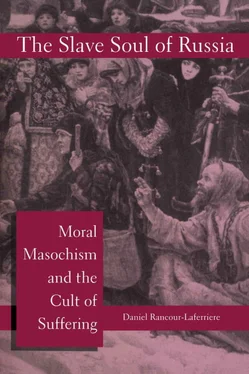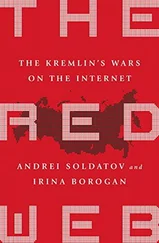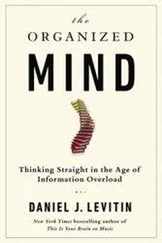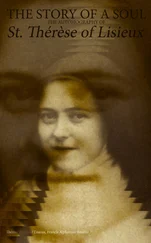The masochistic practices of many of the holy monks were accompanied by paranoid fantasies or hallucinations (“demonology” is the theological euphemism for this). Theodosius said he was haunted by a “black dog” while praying. The recluse Isaac was pestered by demons who tricked him by taking the form of angels. The “much-suffering” John went about in nothing but chains and once tried to relieve his suffering by digging himself into the earth, where he experienced a terrible hallucination: “Over his head he saw the mouth of a horrible serpent belching flames. When the paschal night came, the serpent took the recluse’s head and arms into its mouth and scorched his hair. Out of the serpent’s mouth John cried to God, and the fiend disappeared.” 18
Perhaps the examples of religious suffering I have cited are extreme, and in some cases not credible. Yet it is generally acknowledged that the East Slavic holy men and holy women were indeed ascetic to a greater or lesser extent. Perhaps not all of them went to such great lengths at punishing themselves as the canonized saints were alleged to have gone. On the other hand, the less illustrious holy persons may have gone even further. Speaking of the relatively uneducated monks of the sixteenth century, Bolshakoff says:
Contemplation, the Prayer of Jesus and serious meditation on the Scriptures were replaced by extreme rigorism in the observance of a multitude of rites and by an astonishing severity in bodily mortifications. Long vigils, endless services, countless prostrations, extraordinary penances and fasting were de rigueur for every good monk, who, however, understood but little of the Scriptures and the Fathers. 19
The population of these sufferers in old Russia must have been substantial during some periods. For example, in 1700, before Peter the Great imposed cutbacks, there were 1,200 monasteries in Russia. The figure for 1900 is 800 monasteries (300 of them nunneries), housing 17,000 professed monks and nuns, and nearly 30,000 novices of both sexes. 20If religious suffering can be quantified (and even allowing for a decrease of asceticism over the centuries), these numbers are eloquent. They bespeak a religious masochism of massive proportions. 21
Not without reason does James Billington speak of “an almost masochistic doctrine of ascetic discipline” and “the almost masochistic desire of the… monks to humble themselves.” 22Actually, the qualifier “almost” is quite unnecessary here. In similar fashion George Fedotov says: “The evaluation of suffering as a superior moral good, as almost an end in itself, is one of the most precious features of the Russian religious mind.” 23Again, the “almost” may be deleted. Suffering is masochistic in nature, it is an end in itself for the religious sufferers—which is not to deny that other ends also exist for such sufferers. In the case of monastic asceticism the most frequently mentioned end is of course spiritual perfection and union with God, and the eloquent writings of Nil Sorsky, Seraphim of Sarov, and some others testify to the mystical ecstasy which can sometimes be induced (in part) by self-denial and self-punishment.
There are signs of a revival of monasticism in Russia at the end of the twentieth century. 24But it is not yet clear to what extent this revival will involve specifically ascetic/masochistic features.
Related (psychologically) to monastic asceticism is the Russian tradition of holy foolishness. The holy fool or fool in Christ (“iurodivyi Khrista radi”) was a familiar figure in all Russian towns up until (and in some cases even after) the Bolshevik Revolution. Russians had a special fondness for the holy fools. As Slavophile philosopher Ivan Kireevsky said, “the Russian had a greater respect for the rags of the holy fool than the golden brocade of the courtier.” 25
Psychoanalytically viewed, the holy fool was a sufferer, part of whose masochism was specifically provocative or exhibitionistic in style. Giles Fletcher, English ambassador to Russia in 1588—89, describes the phenomenon:
They vse to go starke naked, saue a clout about their middle, with their haire hanging long and wildely about their shoulders, and many of them with an iron coller, or chaine about their neckes, or middes, even in the very extremity of winter. These they take as Prophets, and men of great holines, giving them a liberty to speak what they list without any controulment, thogh it be of the very highest himselfe. 26
Often the “liberty” was paid for, however. Onlookers would verbally abuse or physically attack holy fools, or the authorities might arrest them. Holy fools would resort to all manner of scandalous behavior in order to provoke aggression: they sat on dung heaps, refused to wash, wore little or no clothing; they would dance about, shout obscenities or make incoherent utterances, smash objects, and so on. The sadistic impulse is unmistakable in all this, but the provocative-masochistic tendency overrides it. Kovalevskii demonstrates his awareness of this when he says of Pelagiia Ivanovna, the nineteenth-century holy fool from the Diveevo convent, that “she herself would provoke [vyzyvala] everyone in the community to insult and beat her.” 27Saint Procopii of Ustiug, who lived in the thirteenth century, thanked onlookers for their retaliatory jeers and blows. Vasilii Blazhennyi of Moscow (sixteenth century) was said to willingly accept the curses of those he provoked.
Maksim Gor’kii beautifully captures the exhibitionistic aspect of the holy fool’s masochism: “Don’t You see, Lord, how I torment and lower myself for the sake of Your glory? Don’t you see? Don’t you see, people, how I torture myself for the sake of your salvation? Don’t you see?” 28
Holy foolishness held an appeal not only for those who practiced it, but for many of those who witnessed it as well. Sometimes large crowds would gather around holy fools who were going through their masochistic routines. Impressionable children could not but be influenced by holy foolishness. The future narodnik writer Gleb Uspensky and his childhood friends, for example, admired and even imitated a holy fool named Paramon: “The children began to believe in the possibility of redemption and the happy life that would come in the next world. They followed Paramon around town, fasted, put nails in their shoes, and the child whose shoes first leaked blood became the envy of all the others.” 29
The depiction of holy foolishness in various art forms has its own attraction. Russian literature features numerous examples of holy fools, or characters who resemble holy fools, such as Pushkin’s Nikolka, Nekrasov’s Vlas, Dostoevsky’s Prince Myshkin and Sonia Marmeladova, and Pasternak’s Doctor Zhivago. 30
Quite understandably, Billington associates holy foolishness with “masochistic impulses.” 31This is not to deny that holy fools were doing other things besides being masochistic (e.g., they sometimes offered a form of social protest, they prophesized, some suffered from an autistic disorder, etc.). Nor should we forget that folly for Christ’s sake existed in other branches of Christianity, such as Greek Orthodoxy. It is curious, however, that thirty-six Russian fools have been canonized, while only six Greeks have. Saward is quite justified to speak of the “Russian enthusiasm” for holy foolishness. 32
In the middle of the seventeenth century a new catalyst for masochistic practices developed on the Russian religious scene. It was at this time that a schism (“Raskol”) arose between the official Russian Orthodox Church and a loosely affiliated group which eventually came to be called the Old Believers or Old Ritualists (“staroobriadtsy”). 33At issue were general questions of the growing secularization of Russian culture, the hierarchicalization of church authority, and the acceptability of foreign models for religious behavior. There were also some very specific issues of ritual, especially the question of how to make a proper Sign of the Cross. The Orthodox Patriarch Nikon, influenced by contemporary Greek Orthodoxy, issued instructions proscribing the old practice of using two fingers to cross oneself and requiring that this gesture be performed with three fingers instead. The theological doctrine behind this change is somewhat obscure (apparently three fingers signify the Holy Trinity, two signify the dual, divine-human essence of Christ). But the reaction to the new rule on the part of religious conservatives, such as the notorious Archpriest Avvakum (1620–82), was clear and categorical: “That wolf Nikon, in league with the devil, betrayed us through this crossing with three fingers.” In particular the change in ritual was viewed by Old Believers as an opportunity to become victims:
Читать дальше












